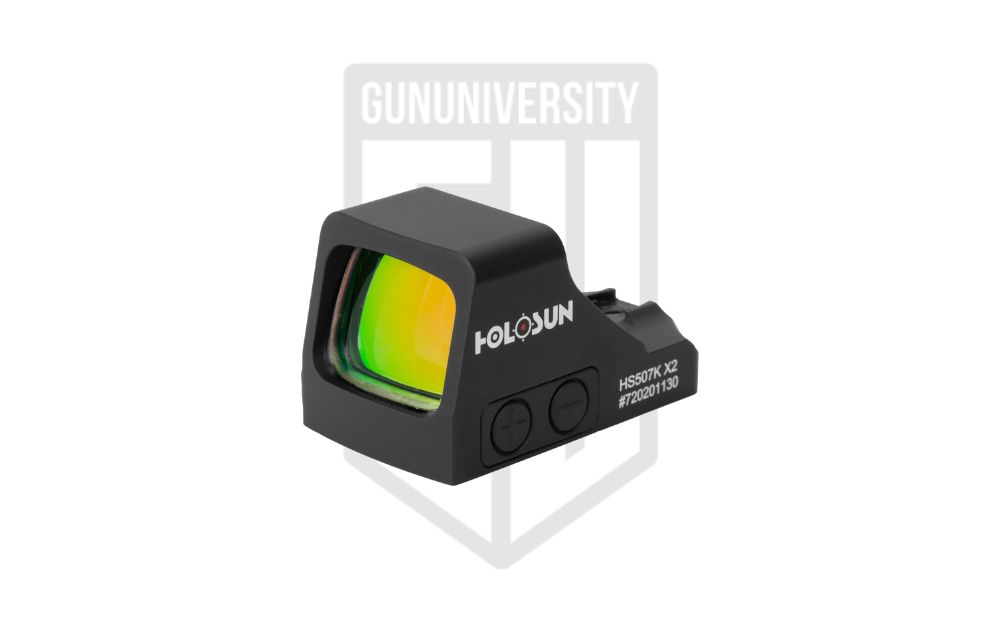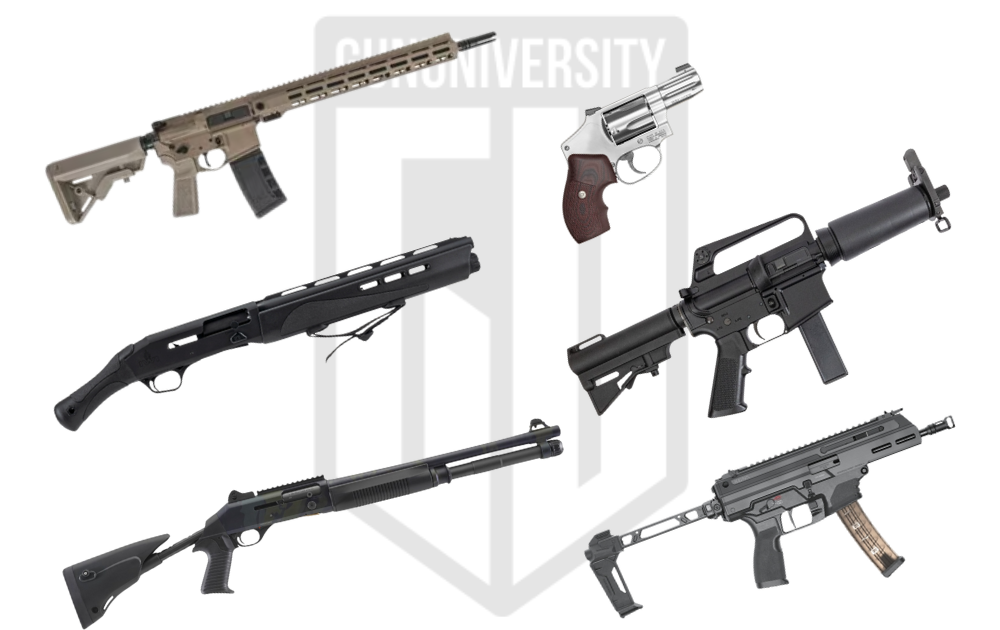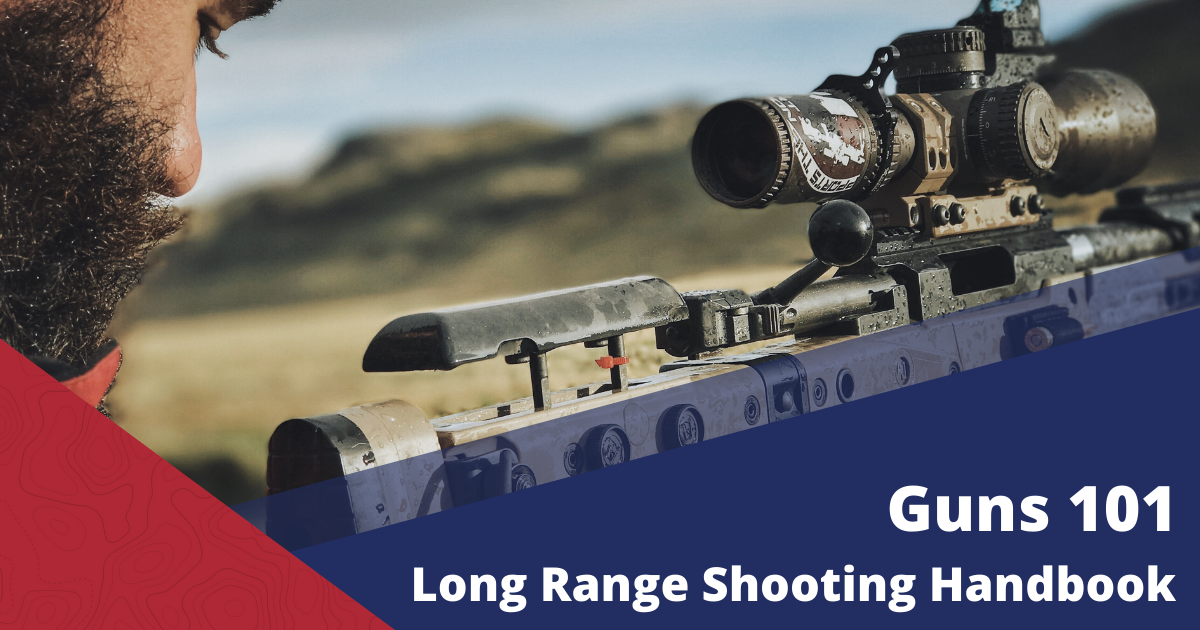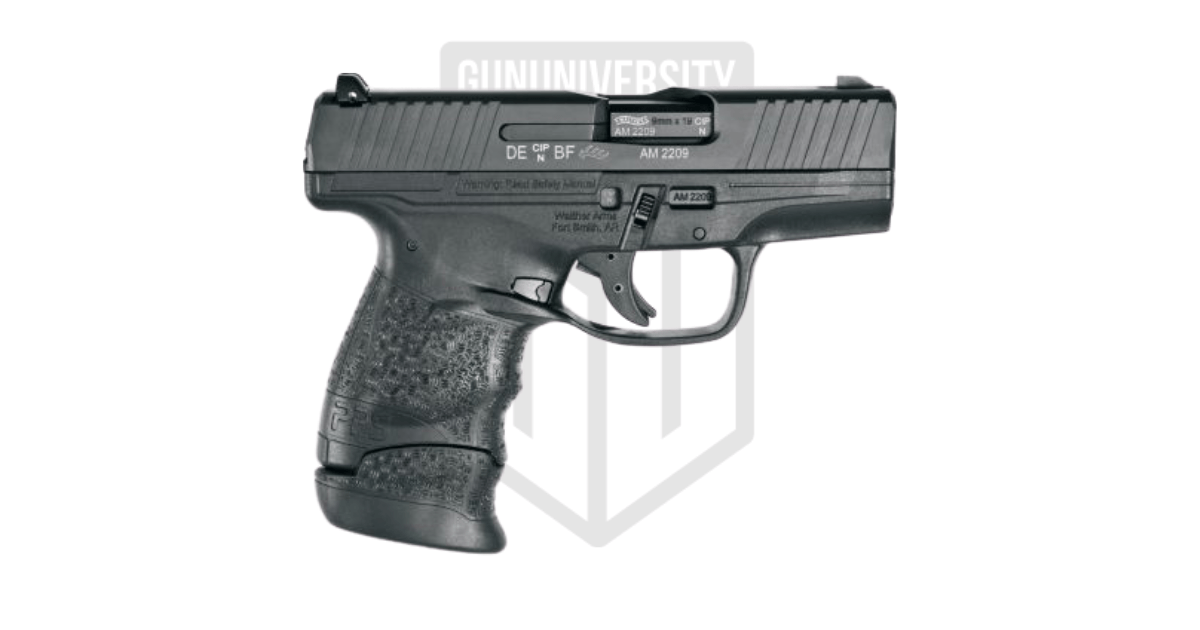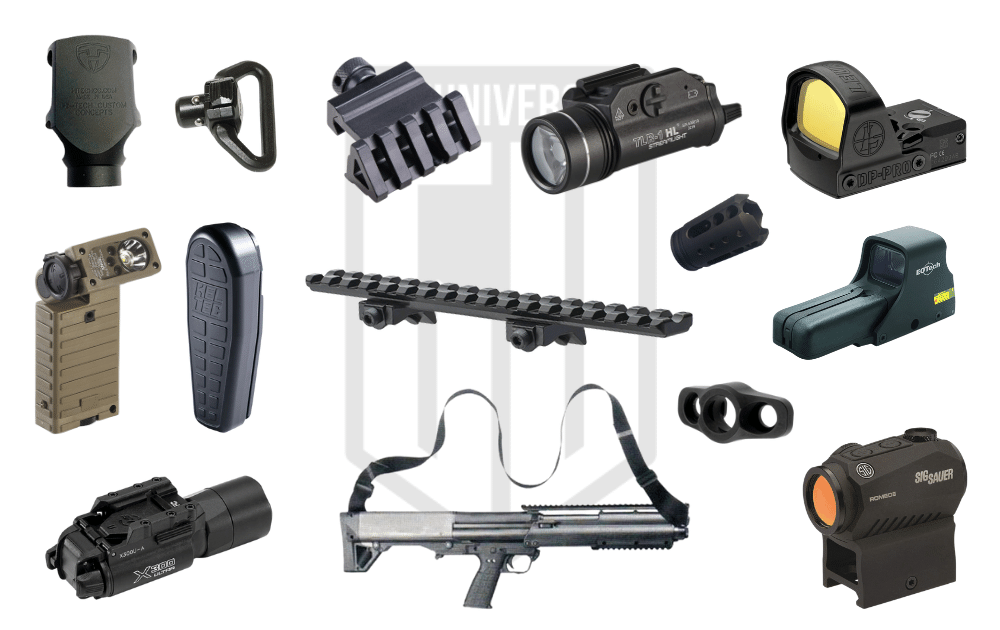7 Best Mini Red Dots: CCW Aiming Cheat Codes!
When we discuss handguns, red dots have really become the new LPVO. What I mean by that is that they are in vogue, so to speak. Most companies who release a handgun in the 2020s are releasing an optic-ready option from the jump. Red dots on handguns have become mainstream in all worlds, from duty and defense to competition shooting. In fact, they’ve migrated to smaller guns, guns that fall into the single stack or micro-compact realm. Today we review the 7 best mini red dots.
The SIG P365, the Kimber Mako, the Hellcat OSP, and so many more now come with optic cut options, and many use the Shield RMSc footprint. It’s nice to see some form of universal footprint amongst firearms. The market for these dots has exploded, and I’ve been lucky enough to try out many micro-sized red dots. Most are pretty solid optics, and I wanted to gather the best for you at all budgets and design types.
Why Red Dots on Little Guns Make Sense
Little guns might be convenient to carry but are often tougher to shoot fast and accurately. A red dot can’t do anything to help aid you in control, but it can help you shoot straighter. Red dots on handguns allow you to shoot faster, further, and with greater accuracy.
The speed comes from not needing to align a front and rear sight. Put the dot on the target and pull the trigger. The longer range comes from the fact the dot is smaller, and you use a target focus versus a front sight focus. Being able to see the target better makes it easier to hit.
On a small gun, we also have sight radius issues. Short barrels and shorter slides make for a shorter sight radius. A sight radius doesn’t make a gun more accurate, but it makes it easier to shoot accurately. Sight radius isn’t a factor when using a red dot. In fact, I’d red dot everything, down to J-frame snub noses if I could.
The obvious downside is the bulk and height added. However, most red dots are fairly small in this genre, and they certainly make up for the height and bulk they add to a gun.
If you have to call your concealed carry gun into action, you want to be able to aim as quickly and accurately as possible. A red dot sight is almost like a cheat code when aiming, allowing you to focus on the threat, while overlaying the red dot, and not having to focus on aligning a front and rear sight. If I was to find myself in a situation involving my concealed handgun, or any handgun, I want all the advantages and overmatch I can get. Wouldn’t you?
Gun University’s Best Mini Red Dot Sights
Best Mini Red Dot
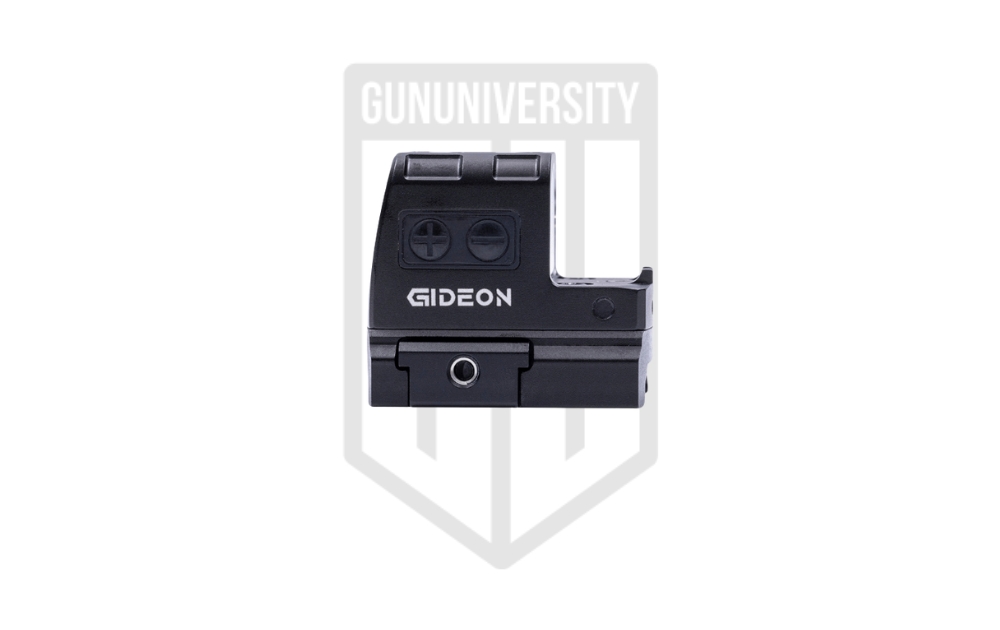 |
| Check Price | |
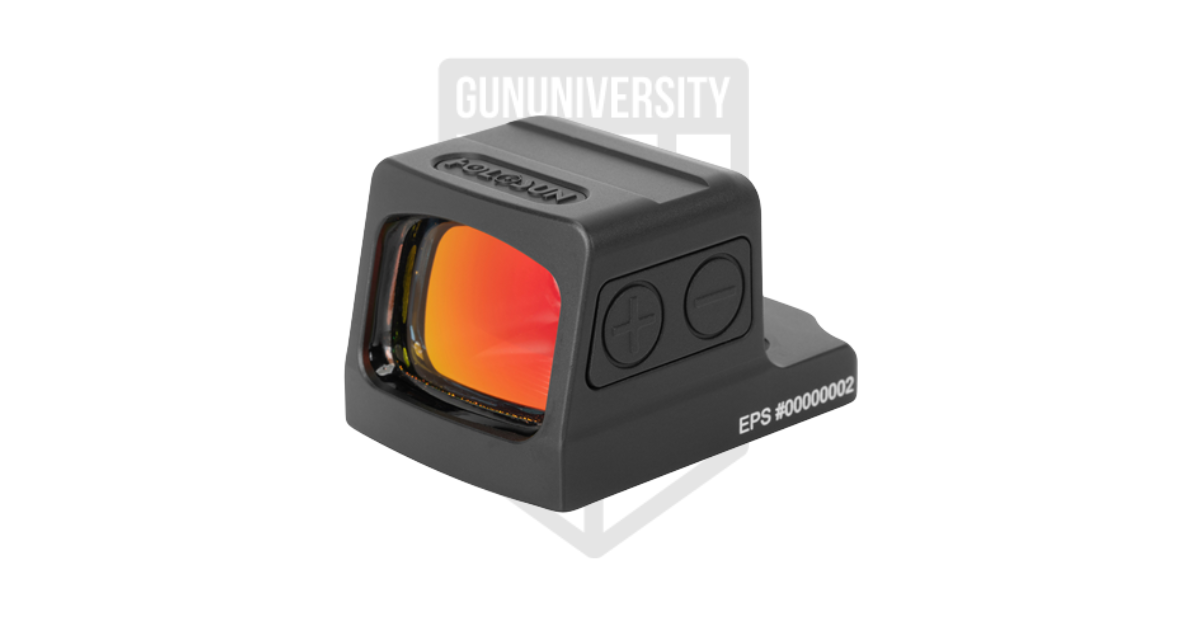 |
| Buy on Amazon | |
 |
| Buy on Amazon | |
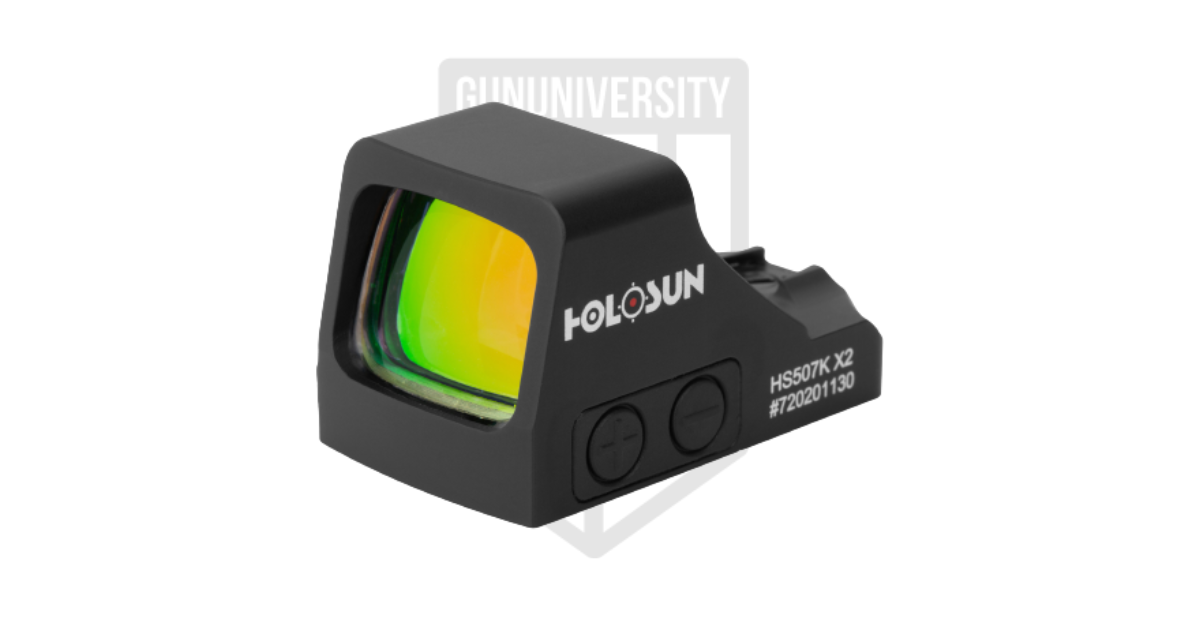 |
| Buy on Amazon | |
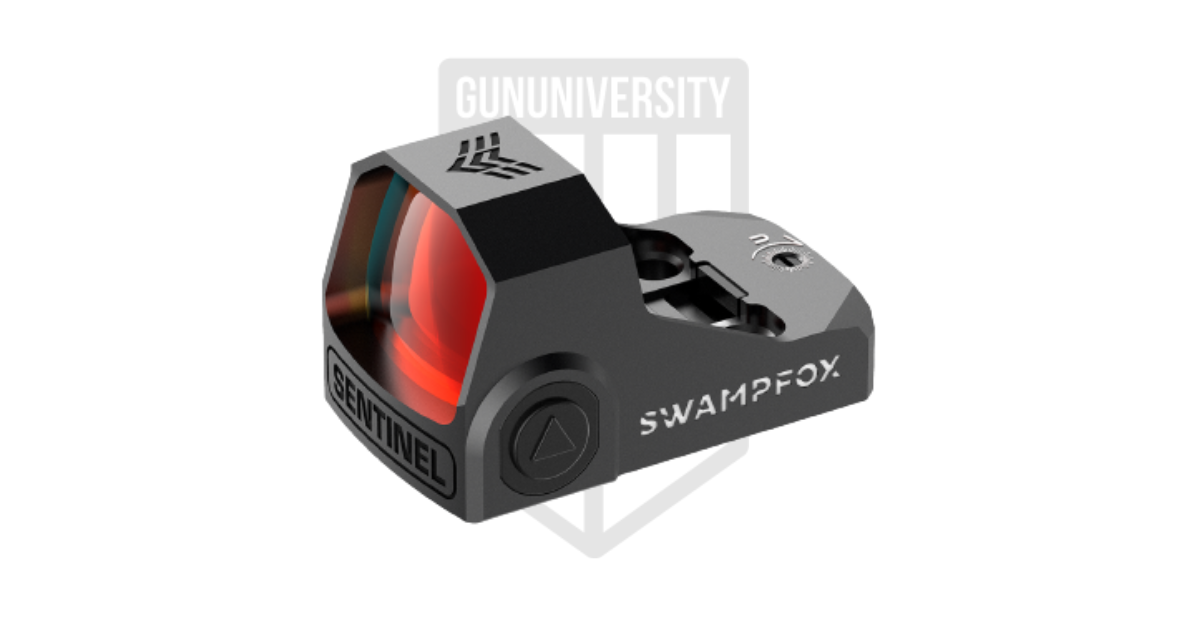 |
| Buy on Amazon | |
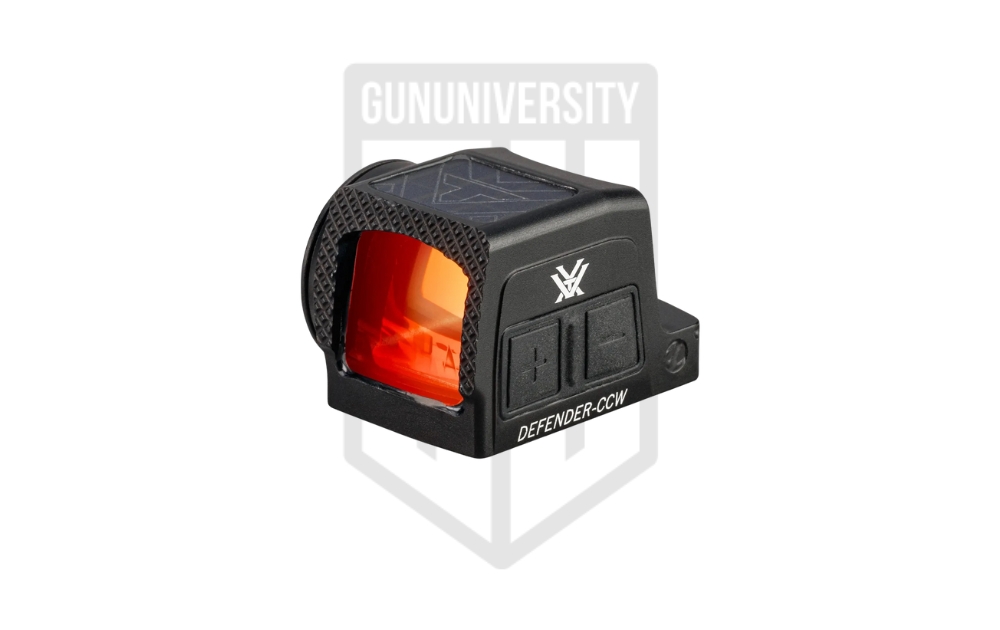 |
| Buy on Amazon | |
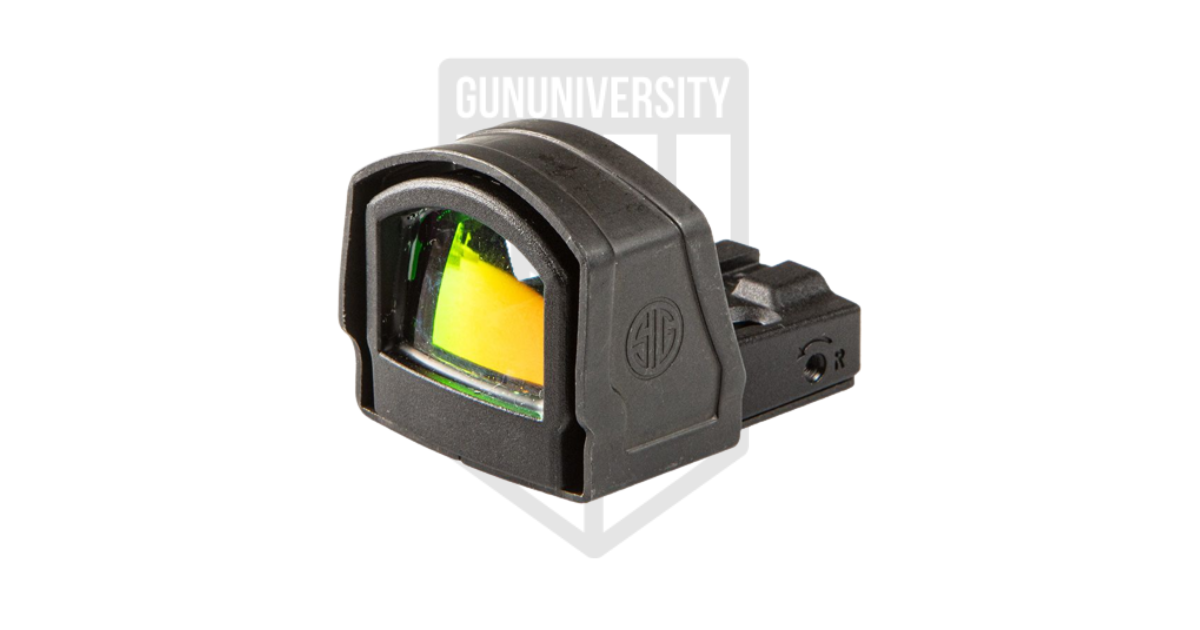 |
| Buy on Amazon |
Best Mini Red Dot Specifications
Below is a table of the specs for each red dot. Click the name of the item to jump to that review.
| Red Dot | Height (in) | Weight (oz) | Reticle Size (MOA) | Battery Life (hours) |
|---|---|---|---|---|
| Gideon Mini Valor | 0.96 | 0.93 | 3 | 50,000 |
| Holosun EPS | 0.99 | 1.4 | 2/6 | 50,000 |
| Cylee CAT EDG | 1.1 | 1.14 | 3 | 50,000 |
| Holosun 507K | 0.95 | 1 | 2 MOA Dot/32 MOA circle | 50,000 |
| Swampfox Sentinel | 0.94 | 0.62 | 3 | 17,520 |
| Vortex Defender-CCW Enclosed | 1.1 | 1.3 | 3 | 35,000 |
| SIG RomeoZero Elite | 0.98 | 0.5 | 3 MOA or 2 MOA Dot/32 MOA circle | 20,000 |
Best Mini Red Dot
Here is our list for the best mini red dot sights:
- Gideon Mini Valor
- Holosun EPS
- Cylee CAT EDG
- Holosun 507K
- Swampfox Sentinel
- Vortex Defender-CCW Enclosed
- SIG RomeoZero Elite
Best Mini Red Dots – Reviews
Here are the detailed reviews of all the mini red dots I’ve listed along with a side-by-side spec table on each. Each one of these red dot sights has unique features which lead to their location on this list.
Gideon Mini Valor Specs
- Height (in) 0.96
- Weight (oz) 0.93
- Reticle Size (moa) 3
- Battery Life (hours) 50,000
Gideon Mini Valor Review
Gideon Optics is a new company that makes a variety of optics. Lots of variable optics. They have also dived into the world of red dots. Yep, red dots. They make a variety of pistol dots and a rifle dot or two. The Mini Valor is their take on a micro-sized EDC optic with the RMSc footprint. Enclosed emitters are the current hotness for their increased reliability.
Enclosed emitter optics tend to be expensive, but that’s not the case here. The Mini Valor can be had for around 250 dollars, which makes it impressively affordable. I use the Mini Valoron my CZ P09 Nocturne, and it’s a wonderful fit. The optic provides a clear view with an awesome amount of clarity. We get a slight blue notch filter, but it’s still clearer than most budget optics.
There are lots of optics that offer multiple reticle, which cna be great. I think a basic dot is still best for most uses on a handgun. The Gideon Mini Valor features a 3 MOA dot and comes in red or green. It’s cray crisp for the price point. The Mini Valor offers a nice clear view that’s tough to beat.
The Gideon Mini Valor is tough. It’s shock-rated, and you can toss all the +P+ ammo you want through it. The optic is IPX7 rated, so it can be submerged up to a meter for 30 minutes. A little rain or a splash won’t hurt it. Shake awake technology helps keep the optic ticking and shuts it off automatically when left motionless. As soon as you grab the gun, your optic fires up and is ready to go.
The Mini Valor is an affordable optic that gives you an enclosed emitter reliability. That’s tough to beat. It’s clear, has great reticles, and modern features that put it a step above its price point.
Gideon Mini Valor Pros and Cons
- Lens –
- Enclosed Emitter–
- Dot Clarity –
- One Reticle Only –Polymer Lens
#2 Holosun EPS
Holosun EPS
A enclosed emitter min red dot sight with a few different reticle sizes and in either red or green.
Holosun EPS Specs
- Height (in) 0.99
- Weight (oz) 1.4
- Reticle Size (moa) 2 or 6
- Battery Life (hours) 50,000
Holosun EPS Review
The Holsoun EPS has started a bit of a revolution. For years we were stuck with open emitters for our small guns. Larger firearms got blessed by the ACRO, the Steiner MPS, and the 509T. Holosun took the 509T and shrunk it to give us the EPS. The EPS, or Enclosed Pistol Sight, gives the little gun an enclosed option for maximum reliability. The EPS uses the Shield RMSc footprint without the need for any adapters or plates.
The Holosun EPS provides shooters with several options and variances. The current options include the standard and slightly smaller carry model. Reticle options vary from 2 to 6 MOA dots, and a model that hasn’t made it to the market promises a multi-reticle system. The Holosun EPS offers an easy access battery door and two buttons for adjustments, with an auto adjustment setting.
The EPS is a rock-solid optic that grants decent clarity and a decent dot. In lens clarity, it lags behind the Shield, but is more than clear enough. The EPS offers great big buttons that are slightly recessed. It takes an intentional press, and an accidental press would be difficult to achieve. It can get awfully bright, and it will satisfy users with a green preference, with both red and green dot options.
My biggest gripe was the lack of tactile or audible clicks when it came time to zero the EPS. That made it difficult to zero the optic efficiently. If you can get past that, the EPS is an awesome and reliable option for concealed carry.
Holosun EPS Pros and Cons
- Closed Emitter –Protects the emitter from water and debris that can block it
- Options –Many different variations
- Battery Life – long battery life
- Weight –Heavy for a micro red dot
Cylee CAT EDG Specs
- Height (in) 1.1
- Weight (oz) 1.145
- Reticle Size (moa) 3
- Battery Life (hours) 50,000
Cylee CAT EDG Review
I had a lot of doubts about Cylee. I labeled them a garbage bin brand without the marketing of Olight. Then I gave a Cylee dot a try and was suitably impressed. The Cylee CAT EDG gives us another enclosed emitter red dot sight that offers you awesome durability, tons of features, and a low price point, but it’s built to be rugged and durable. The CAT EDG isn’t their cheapest optic, but it’s a rock solid reliable optic.
Cylee claims the optic can survive a six-foot drop, on its top, with a 35-ounce handgun, onto concrete. Notice how the CAT EDG has a weird design on the top of the optic? That’s there to help provide more durability and strength to the enclosed emitter design. This helps ruggedize the optic and prevents the drop from damaging the optic with strategic reinforcement.
The Cylee uses 7075 to construct the CAT EDG, which is the same metal used in AR lowers and uppers. It’s tough and durable, and certainly not plastic. The lens is also recessed, which offers a ton of protection to the most fragile part of the optic.
Looking through the lens, we get a clear view with a slightly bluish tint to it. The red dot is a 3 MOA circle that’s impressively clear for its design. It features a shake-to-wake function to extend battery life, and the battery is conveniently side-mounted for easy access. It’s a solid optic, and Cylee might be the up-and-comer people need to watch.
Cylee CAT EDG Pros and Cons
- Price –Super Affordable
- Dot –Surprisingly Nice Dot
- Heavy –
#4 Holosun 507K
Holosun 507K
A min red dot sight available in either red or green with either with a multi reticle system that has 2 MOA dot and a 32 MOA circle.
Holosun 507K Specs
- Height (in) 0.95
- Weight (oz) 1
- Reticle Size 2 MOA Dot/32 MOA circle
- Battery Life (hours) 50,000
Holosun 507K Review
The Holosun 507K was the first real Micro-Sized red dot that offered the durability needed for concealed carry. It pioneered the microdot market and went on to inspire changes with both SIG and Shield to produce tougher optics. Not only was the 507K concealed carry-worthy, but it packed all the features Holosun had become well known for.
This includes the multi-reticle system. The 507K packed a 2 MOA dot, a 32 MOA circle, and a combination of the dot and circle. The circle, in particular, is great for some shooters with astigmatism. It doesn’t work for all, but for some, it’s the only option for clarity’s sake. I actually don’t mind the massive 32 MOA circle, although it takes up a lot of your lens. If you are focused only on close-range shooting, it’s massive and tough to beat.
The optic features two push-button controls and a battery door for easy battery swaps. It’s smartly designed and easy to attach to your gun of choice. At the rear, a small notch serves as a rear sight. This is handy on guns like the P365, where removing the rear cover removes the rear sight. The 507K packs shake awake technology to preserve battery without compromising your use need.
The 507K packs most of the features I want in an optic. If I had a complaint, it would be the buttons are tiny, likely due to the Trijicon lawsuit. They’ve returned to large buttons on the EPS, but the 507K is stuck with the little fellas. If you can get passed small buttons, there is a lot of optic to appreciate in a very small package.
Holosun 507K Pros and Cons
- Durability –Great Durability
- Reticles –Multiple Reticles
- Battery Location –Easy to Swap Batteries
- Lens –Heavy blue tint on the lens
#5 Swampfox Sentinel
Swampfox Sentinel
A min red dot sight available in either red or green with a 3 MOA dot and with an optional auto brightness feature.
Swampfox Sentinel Specs
- Height (in) 0.94
- Weight (oz) 0.62
- Reticle Size (moa) 3
- Battery Life (hours) 17,520
Swampfox Sentinel Review
Swampfox is another budget brand that makes some rather nice optics. The Sentinel is simple but good-looking and well-designed. The little optic uses the RMSc footprint and comes with a 16mm window that is made from polymer. While the window is polymer, they make the body of the optic from CNC machine 7075 aluminum for a durable but lightweight design.
The Sentinel can withstand a dunk worth of water exposure, so occasional rain and splashes aren’t an issue. Don’t go swimming with it and make sure you install the flexible seal between the battery and the slide. The optic can resist 1500Gs of force, making it just fine on your reciprocating slide. The polymer lens comes with an anti-scratch coat that will help it resist the frailty of polymer.
The optic comes in either an always-on, auto-brightness model or a manual model. You can also pick between a green or red reticle. I like the manual option with the shake awake technology. A 3 MOA reticle is easy to see and perfectly crisp for easy shooting.
Sadly, the battery goes in the bottom of the optic, meaning you gotta remove it to swap batteries out. The battery lasts two years of constant on, so you won’t have to make the switch often. It’s that’s any consultation. The Sentinel is probably the toughest optic you can get for such a low price point.
Swampfox Sentinel Pros and Cons
- Auto Brightness– Auto brightness adjusting option available
- Ironsides Shield– Available stainless steel housing
- Battery Location – Bottom loading battery
Vortex Defender-CCW Enclosed Specs
- Height (in) 1.1
- Weight (oz) 1.3 ounces
- Reticle Size (MOA) 3 and 32 MOA
- Battery Life (hours) 35,000
Vortex Defender-CCW Enclosed Review
Vortex is rapidly improving its Defender line of red dot sights. The new Defender-CCW Enclosed brings enclosed emitter goodness to the micro optic variant of the Defender-CCW. The optic combines a lot of the features that made the Defender-CCW excellent with a number of new and fascinating features. The Defender-CCW Enclosed fits the RMSc footprint and can mount to a wide variety of handguns.
The Defender-CCW Enclosed keeps the same tough design of the original Vortex Defender-CCW, but now it’s even tougher. Seriously, adding an enclosed emitter design ratchets the reliability up to the next level. The Defender-CCW Enclosed features large, easy-to-use buttons that offer tactile feedback, enabling quick adjustments through its 12 brightness settings, including two for night vision compatibility.
The battery life is listed at 35,000 hours, which makes it below standard. To back that battery up, we do get an aggressive shake awake design that shuts the optic down when it’s left stationary and fires it back up when moved. Additionally, these new enclosed designs feature a solar panel to give you backup power
The optics also come with multiple reticles. You get a 3 MOA dot, a 32 MOA circle, and a combination of both the 3 MOA dot and 32 MOA circle. This is my favorite multi-reticle system purely because it gives you a 3 MOA option for red dots instead of a tiny 2 MOA dot. The Vortex Defender-CCW Enclosed is an impressive optic that’s also fairly affordable.
Vortex Defender-CCW Enclosed Pros and Cons
- Ergonomics –Great Ergonomics
- Window Size –Large Window
- Innovation –Innovative Shockshield Insert
- Battery Life –Short Battery Life
#7 SIG RomeoZero Elite
SIG RomeoZero Elite
A min red dot sight with a polymer housing and removable steel shroud and a glass lens available with either 3 MOA dot or 2 MOA dot with a 32 MOA circle.
SIG RomeoZero Elite Specs
- Height (in) 0.98
- Weight (oz) 0.5
- Reticle Size 3 MOA or 2 MOA Dot/32 MOA circle
- Battery Life (hours) 20,000
SIG RomeoZero Elite Review
The SIG RomeoZero optic was one of the first micro-sized red dots to hit the market. It was right behind the Sheild. Sadly, it wasn’t quite up to snuff, and SIG went back to the drawing board to develop the RomeoZero Elite. This new optic is durable, well made, and will take the abuse concealed carry will throw at it. SIG Built the RomeoZero Elite to be durable all by itself but also implemented an optional metal shield that provides another degree of durability.
The RomeoZero Elite also implemented a glass lens system to increase clarity and durability. Its lens offers zero distortion and is one of the clearer options that rivals the Shield for the best clarity possible. The RomeoZero Elite offers you the choice of two reticles, one being a 2 MOA dot and the other being a 32 MOA circle for astigmatism sufferers.
The RomeoZero Elite lasts for 20,000 hours with eight daylight settings. It appears at first to not have any controls, but when you look inside the optic, you see a single button control. This is the SIG TAPS system. It has a single button control that allows you to control the optic, though it is admittedly oddly placed. At least it’s odd for my big hands and I smudge the lens with every press.
SIG RomeoZero Elite Pros and Cons
- Reliability –Durable and Reliable
- Price –Affordable
- Reticles –Multi reticle
- Button –Weird Button Placement
Red Dot Madness
Before we go, let’s dig into some of the features we discussed when we picked our red dots. If you were a bit confused by certain terms, I hope to better explain them here, so you have a clearer overall picture.
Enclosed or Open Emitters
Most of the red dots on this list and most pistol red dots are open emitters. This means that they consist of a single lens with the emitter placed behind the lenses. It’s often easy to see when looking down at the red dot base. With an open emitter, you get a smaller, lighter optic. The design also offers great clarity due to a single lens and is typically more affordable.
An open emitter allows for debris, moisture, and more to get between the lens and the emitter. The most common issue is rain. When this occurs, the rain washes out the dot and interrupts the reticle, rendering it useless..
Enclosed emitters add a hood and a second piece of glass to the design. This adds some weight, some bulk, and two lenses that rely on clarity. It envelops the emitter, protecting it from debris, rain, snow, dirt, and anything else that can be thrown at it. The downside is not only being a bulkier optic, but a more expensive one as well.
Dot Size
When we talk about dot size, we are talking about how large your reticle is. We measure reticle size in MOA, or Minutes of Angle. We won’t go deep into this, but it’s important to know that 1 MOA is essentially 1 inch at 100 yards. So if your dot is 1 MOA in size, it’s covering one inch of a target at 100 yards. If it’s 6 MOA, it’s covering 6 inches at 100 yards.
As you get closer, the dot covers less of the target. When it comes to dot size, you typically want to find what works well for you. You typically have to compromise between a dot that will not obscure your target too much, but will also be large enough to see easily.
On small guns, a big dot can often be valuable for close-range shooting. A 6 MOA dot would be considered large and is easy to use between five yards and 50 yards. However, it’s far from the only viable option. Plenty of people use 3.25 MOA dots and even 2 MOA dots, and they all work. It’s really on the shooter and what they prefer.
To Co-witness or Not
When we talk co-witness, we mean talking about using your iron sights in coordination with your red dot. A red dot raises your sighting plain to the point where you can’t necessarily see or use your front and rear sights. To co-witness, you’ll likely need taller sights. They commonly refer to these sights to as suppressor height sights. They stand tall enough to see when looking through the optic.
With micro-sized guns and optics, you don’t have a lot of room, so a number of optics institute a rear sight built into the optic. This means you’ll only need a front sight at suppressor height. The real question is, how important are they? Especially with small guns.
I think they are important, and my chosen carry gun and optic allow me to use the notch in my rear sight with my front sight. I’ve broken more iron sights than I have red dots. However, I like the idea of having a second sighting system just in case something goes wrong with my electronic sighting system.
Zeroing Micro Dots on Small Guns
Before we leave, let me give you some tips on how to set yourself up for success. Your ability to zero your micro-sized red dot depends on your ability to shoot well. Small handguns are tough to shoot, so it’s often hard for shooters to make a small group at 25 yards with a small gun.
I suggest zeroing first at ten yards and using a rest. A rest allows your arm to sit still and helps eliminate some of the human error factor. Shoot at ten yards and follow your optic’s instructions on how to zero until you are producing a tight group at the point of aim. Do not zero the dot to your iron sights. Slaving the dot to the sights eliminates some benefits of a red dot, so just avoid that.
If you can easily zero at 10 yards, move to 15 and check your zero. It will probably be close. I would continue to zero at greater distances until your skill level tops out and you can no longer produce tight groups.
Sighting In
Little guns get big benefits from red dots. I’ve become a convert and love the dot on my P365XL. I think it’s the next step in the evolution of handguns. A good dot can take you a long way and is the superior sighting system. What do you think? Share below!
Recent Posts
December 15, 2025
December 15, 2025
December 12, 2025
December 12, 2025

